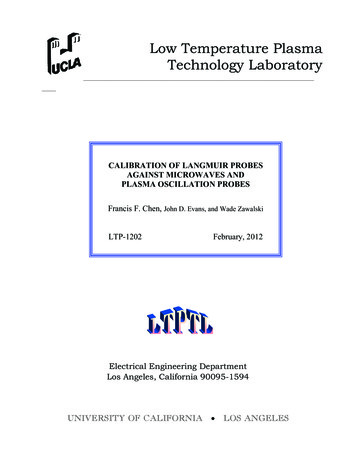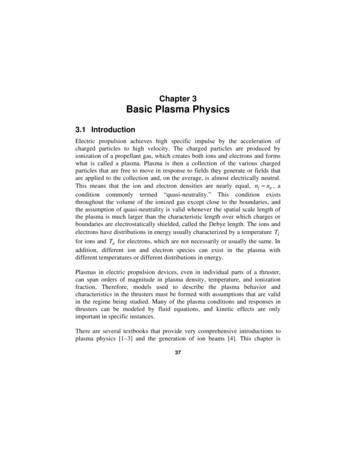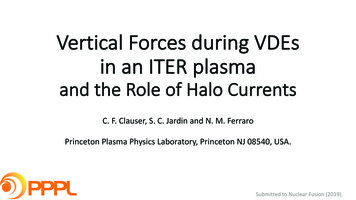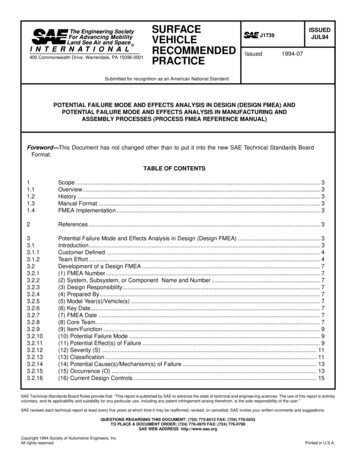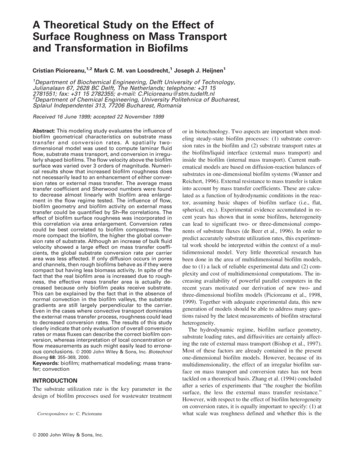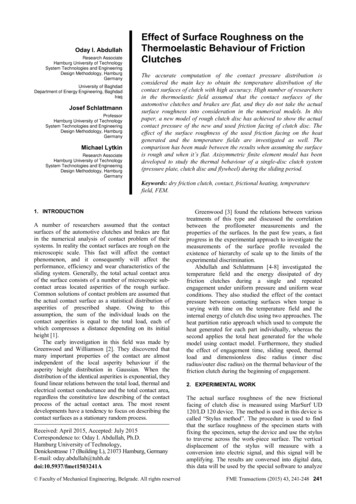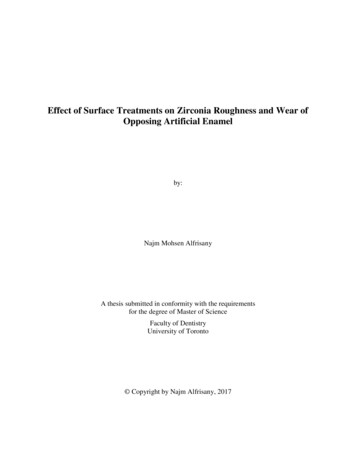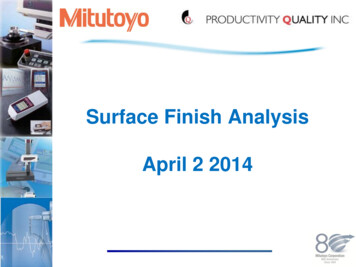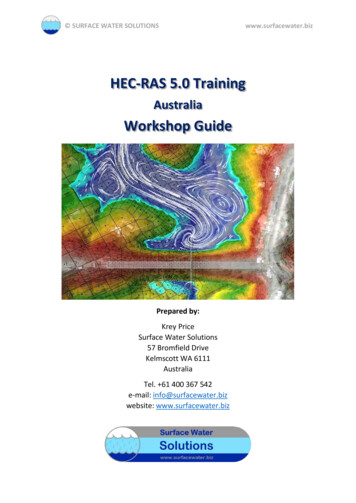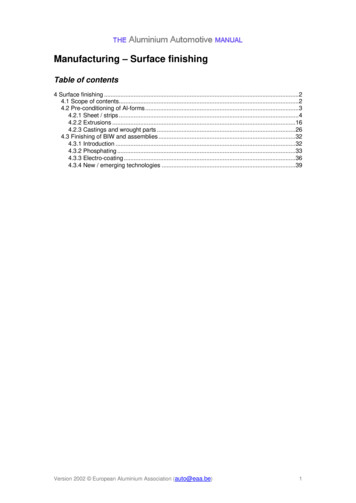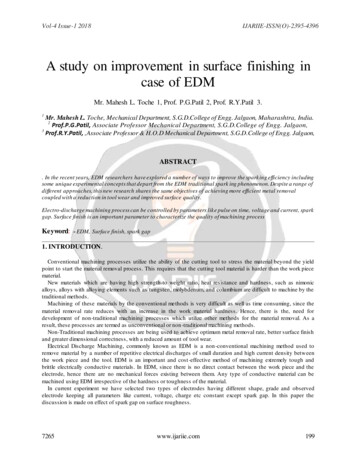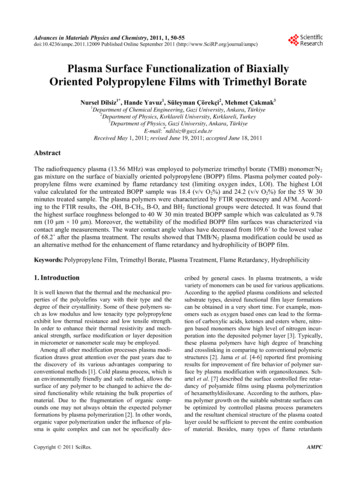
Transcription
Advances in Materials Physics and Chemistry, 2011, 1, 50-55doi:10.4236/ampc.2011.12009 Published Online September 2011 (http://www.SciRP.org/journal/ampc)Plasma Surface Functionalization of BiaxiallyOriented Polypropylene Films with Trimethyl BorateNursel Dilsiz1*, Hande Yavuz1, Süleyman Çörekçi2, Mehmet Çakmak31Department of Chemical Engineering, Gazi University, Ankara, Türkiye2Department of Physics, Kırklareli University, Kırklareli, Turkey3Department of Physics, Gazi University, Ankara, TürkiyeE-mail: *ndilsiz@gazi.edu.trReceived May 1, 2011; revised June 19, 2011; accepted June 18, 2011AbstractThe radiofrequency plasma (13.56 MHz) was employed to polymerize trimethyl borate (TMB) monomer/N2gas mixture on the surface of biaxially oriented polypropylene (BOPP) films. Plasma polymer coated polypropylene films were examined by flame retardancy test (limiting oxygen index, LOI). The highest LOIvalue calculated for the untreated BOPP sample was 18.4 (v/v O2%) and 24.2 (v/v O2%) for the 55 W 30minutes treated sample. The plasma polymers were characterized by FTIR spectroscopy and AFM. According to the FTIR results, the -OH, B-CH3, B-O, and BH2 functional groups were detected. It was found thatthe highest surface roughness belonged to 40 W 30 min treated BOPP sample which was calculated as 9.78nm (10 μm 10 μm). Moreover, the wettability of the modified BOPP film surfaces was characterized viacontact angle measurements. The water contact angle values have decreased from 109.6 to the lowest valueof 68.2 after the plasma treatment. The results showed that TMB/N2 plasma modification could be used asan alternative method for the enhancement of flame retardancy and hydrophilicity of BOPP film.Keywords: Polypropylene Film, Trimethyl Borate, Plasma Treatment, Flame Retardancy, Hydrophilicity1. IntroductionIt is well known that the thermal and the mechanical properties of the polyolefins vary with their type and thedegree of their crystallinity. Some of these polymers such as low modulus and low tenacity type polypropyleneexhibit low thermal resistance and low tensile strength.In order to enhance their thermal resistivity and mechanical strength, surface modification or layer depositionin micrometer or nanometer scale may be employed.Among all other modification processes plasma modification draws great attention over the past years due tothe discovery of its various advantages comparing toconventional methods [1]. Cold plasma process, which isan environmentally friendly and safe method, allows thesurface of any polymer to be changed to achieve the desired functionality while retaining the bulk properties ofmaterial. Due to the fragmentation of organic compounds one may not always obtain the expected polymerformations by plasma polymerization [2]. In other words,organic vapor polymerization under the influence of plasma is quite complex and can not be specifically desCopyright 2011 SciRes.cribed by general cases. In plasma treatments, a widevariety of monomers can be used for various applications.According to the applied plasma conditions and selectedsubstrate types, desired functional film layer formationscan be obtained in a very short time. For example, monomers such as oxygen based ones can lead to the formation of carboxylic acids, ketones and esters where, nitrogen based monomers show high level of nitrogen incurporation into the deposited polymer layer [3]. Typically,these plasma polymers have high degree of branchingand crosslinking in comparing to conventional polymericstructures [2]. Jama et al. [4-6] reported first promisingresults for improvement of fire behavior of polymer surface by plasma modification with organosiloxanes. Schartel et al. [7] described the surface controlled fire retardancy of polyamide films using plasma polymerizationof hexamethyldisiloxane. According to the authors, plasma polymer growth on the suitable substrate surfaces canbe optimized by controlled plasma process parametersand the resultant chemical structure of the plasma coatedlayer could be sufficient to prevent the entire combustionof material. Besides, many types of flame retardantsAMPC
N. DILSIZwhich are available in consumer products are mainlycomposed of phosphorus, antimony, aluminum, chlorides,bromides [8-10] and boron-containing compounds. During the thermal degradation of polymers, borates leads tothe formation of impenetrable glass coatings on the surface of materials, therefore they can be classified in theeffective flame retardants [11].In this current research, BOPP films were modified inTMB/N2 gas mixture in order to improve the flame retardancy of polymer films. To describe and to measurethe properties of BOPP films response to heat and flame,Limiting Oxygen Index (LOI) method was evaluated.Fourier Transform Infrared Spectroscopy (FTIR) wasused in the determination of the chemical structure offunctionalized surface. Atomic Force Microscopy (AFM)and wettability measurements were carried out to characterize the surface properties of BOPP films. The resultsshowed that TMB/N2 plasma modification could be usedas an alternative method for the enhancement of flameretardancy and hydrophilicity of BOPP film.2. Experimental2.1. MaterialsBiaxially oriented polypropylene films (BOPP, thickness:40 μm), which were supplied by Super Film A.S. (Gaziantep, Turkey), were used as received. Trimethyl borate(TMB), B(OCH3)3 was supplied by Fluka (Germany). Thecode of materials used in this study is given in the Table 1.2.2. Surface Modification of BOPP FilmsThe radio frequency (RF) plasma was generated byDiener Electronic Pico UHP system (Germany) at 13.56MHz with an electrical power ranging between 0 W and100 W. The applied discharge power of 30 W, 40 W, 55W, and 80 W was chosen. The impedance match between the reactor chamber and the radiofrequency generator was optimized by the matching network, whichprovided power loses at the minimum. The dimension ofa cylindrical shaped quartz plasma reactor was 130 mm(diameter) 300 mm (length) and two copper electrodes were located on the reactor externally. A combination of cold trap and vacuum pump was used to maintainthe pressure range in the reactor between 0.1 mbar and 1mbar. In the absence of the TMB/N2, the pressure of thereactor was decreased to about 0.1 mbar. The BOPP filmand NaCl crystal were used as the substrates onto whichthe plasma polymer films were deposited and were placedin the reactor and treated simultaneously with the sameplasma conditions. The plasma polymer coated on the NaClcrystals were used to determine the FTIR spectra of theCopyright 2011 SciRes.51ET AL.Table 1. Code of materials used in this study.Specimen codeDescriptionBOPPUntreated biaxially oriented polypropylenefilmBOPP-N2TMB30W30MAt 30 W and for 30 min nitrogen gas andtrimethyl borate plasma treated BOPP filmBOPP-N2TMB40W30MAt 40 W and for 30 min nitrogen gas andtrimethyl borate plasma treated BOPP filmBOPP-N2TMB55W30MAt 55 W and for 30 min nitrogen gas andtrimethyl borate plasma treated BOPP filmBOPP-N2TMB80W30MAt 80 W and for 30 min nitrogen gas andtrimethyl borate plasma treated BOPP filmNaClUntreated pure NaCl crystalNaCl-N2TMB30W30MAt 30 W and for 30 min nitrogen gas andtrimethyl borate plasma treated NaCl crystalNaCl-N2TMB40W30MAt 40 W and for 30 min nitrogen gas andtrimethyl borate plasma treated NaCl crystalNaCl-N2TMB55W30MAt 55 W and for 30 min nitrogen gas andtrimethyl borate plasma treated NaCl crystalNaCl-N2TMB80W30MAt 80 W and for 30 min nitrogen gas andtrimethyl borate plasma treated NaCl crystalpolymer film. The substrates were pretreated in theplasma chamber with argon gas before each plasma operation to clean and to improve the adhesion of the flameretardant coating. When the TMB/N2 mixture was fedinto the reactor by a needle valve, the pressure was adjusted to 0.26 mbar - 0.30 mbar and was kept at that levelduring the plasma operation. Polymerization were carriedout for TMB/N2 under different discharge power andplasma exposure time was kept constant at 30 minutes.Additionally, the effluents from the reactor in whichplasma polymerization took place were discharged through a piping system. After the completion of treatment,argon was fed into the reactor for 15 min to deactivatefree radicals. For a given conditions, all experimentswere carried out as triplicate.2.3. Characterization of Plasma SurfaceModified BOPP FilmsFTIR spectra of the plasma polymers deposited on NaClwere recorded by using Jasco 480 Plus FTIR spectrometer having an 8 cm–1 resolution. FTIR spectroscopy wasAMPC
N. DILSIZ52used to determine the functional groups present in amolecule. The infrared region was taken from 4000 cm–1to 400 cm–1 wavenumbers where the most vibrationsmainly occur.In order to determine the effect of the deposited filmlayer on the surface topography, the BOPP samples wereexamined by atomic force microscopy (AFM). Surfacetopography of TMB/N2 plasma modified BOPP film wasinvestigated by AFM operated in tapping mode on anOmicron VT STM/AFM Instrument. The main objectiveof the collection of AFM images is to measure the atomic level forces between the sample surface and the probe. Acquiring images over a small area is possible withthe small probe-specimen separation, thus, in this workscanning ranges were adjusted to 10 μm 10 μm. Theimages were collected while the tip was operated at Tapping Mode. Roughness (RMS) was determined as a meanfrom five AFM scans over the same area.Fire response of plasma modified BOPP films werestudied according to the LOI test method under controlled laboratory conditions described in ASTM D 2863-00standard [13]. Dynisco LOI polymer test equipment wasused to determine the flammability of the films accordingto the ASTM D 2863 standard. According to the testmethod, flexible films (e.g. BOPP films) should be supported vertically in the center of a heat resistant transparent chimney and tested in accordance with the test methodB. At least fifteen specimens were prepared in order tomaintain LOI and fire response unmodified and eachplasma modified sample. In order to assess fire responseof individual test specimens, period and extent of burningwere considered. Dixon’s “Up-and-Down” method, whichis described in ASTM D 2863-00 standard, was used tocalculate the LOI of each series of specimens.The wettability tests for the BOPP films were perfor-ET AL.med on Krüss100 DSA equipped with a fast CCD camera.Sessile drop type was selected for the static contact anglesetup, and distilled water was used for the each contactangle measurement. Five separate TMB/N2 plasma modified films were measured to get an average value.3. Results and Discussion3.1. FTIR SpectroscopyThe chemical structure of plasma modified BOPP film,which was treated under N2 gas and TMB vapor, indicatedthat at the surface mainly boron based functional groupswere included. Since the methylene deformations mainlyoccur between 1500 cm–1 and 1300 cm–1 wave numbers,plasma polymer coated NaCl crystals were used to help theidentification of B-CH3, B-O, BH2 functional groups whichconsistently produce absorption bands between 1460 cm–1 1405 cm–1, 1350 cm–1 - 1310 cm–1 and 1205 cm–1 - 1140cm–1, respectively. In order to relate plasma power effectwith constant plasma exposure time (at 30 min), the FTIRspectra were collected as represented in Figure 1. It can beseen that almost all of the plasma polymers obtained fromdifferent (30 W, 40 W, 55 W and 80 W) discharge powergave similar characteristic peaks, indicating similar functional groups in the plasma polymers. In general the relativeintensities of these peaks have varied with increasing discharge power. One of the major peaks observed for allplasma polymers was obtained at 3450 cm–1 - 3100 cm–1,which is mostly due to O-H stretching band. The peak at1460 cm–1 - 1405 cm–1 can be assigned to B-CH3symmetrical deformation and absorption at 1205 cm–1 1140 cm–1 may be assigned to BH2 in-plane deformation[14]. Aditionally, the formation of B-O stretching band wasobserved at 1350 cm–1 - 1310 cm–1 at 30 W discharge power.Figure 1. FTIR spectra of plasma polymers at exact plasma exposure time a) 30 W, b) 40 W, c) 55 W, d) 80 W.Copyright 2011 SciRes.AMPC
N. DILSIZThe formation of new groups in the TMB plasmapolymer (BH2, B-CH3, etc.) is mainly caused by thefragmentation of monomers under plasma conditions.Due to fragmentation of organic compounds in plasmathe polymer formed is not always what one would expectfrom the chemical structure of the monomer [15]. Whenthe discharge power was increased to 55 W, the intensities of the peaks has increased slightly. The absorptionintensities for all plasma polymers seemed to increasefirst upon increasing the discharge power up to 55 W.When the discharge power was raised to 80 W theintensities of all the peaks have decreased. This resultcan be explained by the fact that by increasing dischargepower a growing portion of the modified polymer isablated [16] and thinner layer of modified polymer isavailable for subsequent FTIR measurement. It can beconcluded that the decrease in the peak intensites may bedue to increased decomposition of the deposited polymers with increasing power.3.2. Limiting Oxygen Index (LOI)53ET AL.from AFM images shown in Figure 2. As seen from theimages, surface morphologies of the treated samplesslightly changed compared to the untreated one.Roughness was determined as a mean from five AFMscans over the same area and its dependence on discharge power is given in Table 3. As is shown in Figure2, the effects of different power on surface morphologiesof BOPP film were characterized by AFM. For theuntreated BOPP film, the surface roughness was 5.64 nm.However, after 40 W TMB/N2 plasma treated for 30 min,the fiber surface roughness increased to 9.78 nm. It wasfound that the untreated BOPP film had a smooth surface(Figure 2(a)). It can be found that BOPP films werenotably roughened by the plasma power. The surfaceroughness of plasma polymer modified BOPP filmsenhanced with the plasma power up to 40 W then thesurface rougness slightly decrease with increasing theplasma treatment power. These results indicate thatBOPP film were notably roughened by the TMB/N2plasma treatment.3.4. Contact AngleResults of oxygen index test are given in Table 2. Theresults demonstrate that TMB/N2 plasma polymers modified BOPP film have higher LOI value than the untreatedBOPP film. From Table 2 it can be seen that whenplasma power increases to 30 W, LOI value TMB/N2 plasma treated BOPP film increases from 18.4 (untreatedBOPP) to 23.6 (%O2, v/v). When the plasma power increases to 55 W, the maximum LOI value obtained was24.2 (%O2, v/v). The LOI difference between untreatedand plasma modified films was calculated as approximately 30%. This trend could be related to the depositionof B-O functional groups rather than the deposition ofB-C and/or B-H functional groups, which can be formedin the cold plasma environment, on the surface of theBOPP films. This conclusion was also supported byFTIR spectra given in Figure 1.3.3. Atomic Force MicroscopyThe effect of plasma discharge power on the surfacemorphology of TMB/N2 modified BOPP can be seenTable 2. LOI data for plasma treated BOPP film.Under various discharge conditions, it is found that thechemical structure of the top BOPP film layer waschanged significantly. The relation between the treatmentconditions and contact angle values can be followed inTable 4. It is known that plasma polymer depositionTable 3. Surface roughness of untreated and plasma polymerized BOPP film.Surface roughness (nm)Sample code10 µm 10 µmBOPP5.64 0.83BOPP-N2TMB30W30M7.27 0.72BOPP-N2TMB40W30M9.78 1.25BOPP-N2TMB55W30M7.85 0.52BOPP-N2TMB80W30M6.22 0.48Table 4. Contact angle values of untreated and plasma polymerized BOPP film.Specimen codeContact Angle ( )Untreated BOPP109.6 0.2523.6 0.18BOPP-N2TMB30W30M73.6 2.65BOPP-N2TMB40W30M22.5 0.16BOPP-N2TMB40W30M68.2 1.58BOPP-N2TMB55W30M24.2 0.27BOPP-N2TMB55W30M88.6 5.00BOPP-N2TMB80W30M22.4 0.21BOPP-N2TMB80W30M83.3 0.72Specimen codeLOI (O2%, v/v)Untreated BOPP18.4 0.20BOPP-N2TMB30W30MCopyright 2011 SciRes.AMPC
54N. DILSIZET AL.Figure 2. AFM images of a) Untreated BOPP film; b) BOPP-N2TMB30W30M; c) BOPP-N2TMB40W30M; d) BOPP-N2TMB55W30M; e) BOPP-N2TMB80W30M (10 μm 10 μm).depends strongly on the nature of monomer type anddischarge power. TMB/N2 plasma led to the formation ofpolar groups (e.g. B-O, -OH) on the surface and causedthe removal of some C-H groups from the surface ofBOPP film. So that, wettability of surface was increased,samples became more hydrophilic comparing to theoriginal value (108.3 ). While the highest contact anglewas obtained at 55 W (88.6 ), the lowest one was obtained at 40 W (68.1 ). This can be attributed to the introduction of hydrophilic groups (-OH) on the polymersurface which was seen on the FTIR spectra. All theseresults are quite interesting from the point of view ofseeing no linear trend between the discharge power andcontact angle. The differences among these values can beattributed to the change in distribution of polymer deposition due to the applied conditions. There seems to be noobvious correlation between surface roughness and discharge power. It can be seen that AFM images ofTMB/N2 plasma polymers and their structure havechanged considerably upon increasing discharge power.These results follow the same tendency as reported bySvorick et al. [16] It is known that the value of the con-Copyright 2011 SciRes.tact angle is mostly affected by the chemical structureand morphology of the polymer surface layer [17].Various reactions that takes place during plasma polymerization include excitation, ionization, homolitic bondsplitting, molecular fragmentation etc. For a low level ofenergy input, the extent of ionization is low and ionmolecule reactions dominate polymer formation resultingin deposition rate increase with power [18]. Abovecertain levels of energy, there is greater loss of functionalgroups from the monomer resulting in compe- titivepolymerization and ablation [19].4. ConclusionsWe have focused on the plasma modification of BOPPfilms in the presence of TMB/N2 in order to improvetheir tolerance to flame. Thus, in this work biaxially oriented polypropylene films have been examined mainlyby means of their LOI values. It has been stated that theLOI values can be optimized by adjusting the dischargepower and time. When the treatment time kept constantat 30 minutes, and the plasma power was adjusted to 55AMPC
N. DILSIZW, LOI of BOPP films obtained have increased from18.4 to 24.2. It can be seen that the plasma modifiedBOPP films have gained resistance to flame comparingto unmodified samples. Besides, the effects of plasmapolymer deposition on the surface of BOPP film sampleswere studied from the AFM and FTIR results. Theseresults have showed that boron-based functional layerdeposition can be applied to enhance the flame retardancy of BOPP films.5. AcknowledgementsThis work was supported by National Boron ResearchInstitute (BOREN) contact grant number BOREN-2006Ç-02 and The State Planning Organization (DPT) contactgrant number 2001K-120590.6. ReferencesET AL.55Polymerisation,” Macromolecular Materials and Engineering, Vol. 287, No. 9, 2002, pp. 579-582.doi:10.1002/1439-2054(20020901)287:9 579::AID-MAME579 3.0.CO;2-6[8]J. Troitzsch, “International Plastics Flammability Handbook,” Hanser Publications, New York, 1990.[9]M. Sain, S. H. Park, F. Suhara and S. Law, “Flame Retardant and Mechanical Properties of Natural Fibre-PPComposites Containing Magnesium Hydroxide,” PolymerDegradation and Stability, Vol. 83, No. 2, 2004, pp.363-367. doi:10.1016/S0141-3910(03)00280-5[10] S. Zhu and W. Shi, “Thermal Degradation of a NewFlame Retardant Phosphate Methacrylate Polymer,”Polymer Degradation and Stability, Vol. 80, No. 2, 2003,pp. 217-222. doi:10.1016/S0141-3910(02)00401-9[11] C. Martin, J. C. Ronda and V. Cadiz, “Boron-Con
Dynisco LOI polymer test equipment was used to determine the flammability of the films according to the ASTM D 2863 standard. According to the test . (BOPP . AMPC. 55, , , AMPC. Plasma Surface Functionalization of Biaxial
